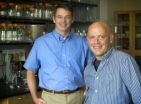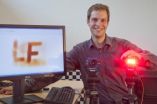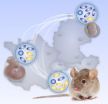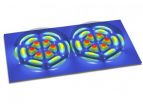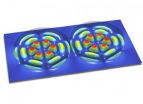(Press-News.org) BETHESDA, MD – June 17, 2014 – Immunity is what stops you dying from a common cold or a tiny pinprick. Differences in resistance or tolerance to disease influence who catches the bug that's going around the office, or which species succumb to the deadly fungus devastating frogs around the world. But immunity involves more than just the immune cells that recognize and hunt down pathogens. It is influenced by the host's health, physiology, behavior, and environment. And underlying all these processes and their intricate interactions are the genes that govern their function.
This broader conception of the genetic underpinnings of host defenses against pathogens reflects the increasing complexity of ideas in this field. Scientists are turning to a wide variety of organisms and approaches to tame this complexity and, in some cases, to use their findings to improve human health. To encourage the emerging conversation between disciplines and to catalyze new advances, the Genetics Society of America journals GENETICS and G3: Genes|Genomes|Genetics have launched an ongoing collection of research articles that address the genetics of immunity. Several articles from the collection are published today in a special section of the June issues of both journals, accompanied by a commentary article that places the articles in context.
So far, articles published in the collection include research on fruit flies, an important genetic model organism, addressing the ways in which the demands of mating and reproduction compete with immunity and how immunity changes with age. Other articles examine crucial applied questions, such as how genes influence autoimmune thyroid diseases, or which chickens are the most resistant to colonization by Campylobacter jejuni, one of the most common causes of food-borne illness in humans. Many more articles are listed in the collection, which will be bolstered by new articles as they are published.
"Defense against infection is profoundly important for our health, and for the agriculture and ecosystems that sustain us. But it is being increasingly recognized that immunity has complex determinants, so genetic research in this area is becoming broader and more diverse. We hope this collection will become a home for much exciting and significant research in this field in the future." says Brian Lazzaro, biologist at Cornell University and one of the editors of the new collection.
The collection includes research from City University of New York, Cornell University, Free University Berlin, German Cancer Research Center, Harvard University, Johns Hopkins University, National Jewish Health and University of Colorado, Trinity College, University of Dublin, University of Maryland, University of Massachusetts, University of Pittsburgh School of Medicine, University of Saskatchewan, University of Texas and the University of Wisconsin–Madison.
INFORMATION:
CITATIONS:
B. Lazzaro and D.S. Schneider The Genetics of Immunity. GENETICS June 2014 197:467-470; doi:10.1534/genetics.114.165449
C. Small, J. Ramroop, M. Otazo, L. H. Huang, S. Saleque, and S. Govind An Unexpected Link Between Notch Signaling and ROS in Restricting the Differentiation of Hematopoietic Progenitors in Drosophila. GENETICS June 2014 197:471-483; doi:10.1534/genetics.113.159210
L. De Arras, R. Laws, S. M. Leach, K. Pontis, J. H. Freedman, D. A. Schwartz, and S. Alper Comparative Genomics RNAi Screen Identifies Eftud2 as a Novel Regulator of Innate Immunity. GENETICS June 2014 197:485-496; doi:10.1534/genetics.113.160499
B. Stronach, A. L. Lennox, and R. A. Garlena Domain Specificity of MAP3K Family Members, MLK and Tak1, for JNK Signaling in Drosophila. GENETICS 197:497-513; doi:10.1534/genetics.113.160937
G. R. Tiller, and D. A. Garsin The SKPO-1 Peroxidase Functions in the Hypodermis To Protect Caenorhabditis elegans from Bacterial Infection. GENETICS June 2014 197:515-526; doi:10.1534/genetics.113.160606
P.R. Johnston, O.M., and J. Rolff Inducible Defenses Stay Up Late: Temporal Patterns of Immune Gene Expression in Tenebrio molitor. G3: Genes|Genomes|Genetics June 2014 4:947-955; doi:10.1534/g3.113.008516
N. Lawless, T.A. Reinhardt, K. Bryan, M. Baker, B. Pesch, D. Zimmerman, K. Zuelke, T. Sonstegard, C. O'Farrelly, J.D. Lippolis, and D.J. Lynn MicroRNA regulation of bovine monocyte inflammatory and metabolic networks in an in vivo infection model. G3: Genes|Genomes|Genetics June 2014 4:957-971; doi:10.1534/g3.113.009936
FS Muhali, TT Cai, JL Zhu, Q Qin, J Xu, ST He, XH Shi, WJ Jiang, L Xiao, DF Li, and JA Zhang Polymorphisms of CLEC16A Region and Autoimmune Thyroid Diseases. G3: Genes|Genomes|Genetics June 2014 4:973-978; doi:10.1534/g3.114.010926
ABOUT GENETICS: Since 1916, GENETICS has published high quality, original research on a range of topics bearing on inheritance, including population and evolutionary genetics, complex traits, developmental and behavioral genetics, cellular genetics, gene expression, genome integrity and transmission, and genome and systems biology. A peer-reviewed and peer-edited publication of the Genetics Society of America, GENETICS is one of the world's most cited journals in genetics and heredity.
ABOUT GSA: Founded in 1931, the Genetics Society of America (GSA) is the professional scientific society for genetics researchers and educators. The Society's more than 5,000 members worldwide work to deepen our understanding of the living world by advancing the field of genetics, from the molecular to the population level. GSA promotes research and fosters communication through a number of GSA-sponsored conferences including regular meetings that focus on particular model organisms. GSA publishes two peer-reviewed, peer-edited scholarly journals: GENETICS, which has published high quality original research across the breadth of the field since 1916, and G3: Genes|Genomes|Genetics, an open-access journal launched in 2011 to disseminate high quality foundational research in genetics and genomics. The Society also has a deep commitment to education and fostering the next generation of scholars in the field. For more information about GSA, please visit http://www.genetics-gsa.org. Also follow GSA on Facebook at facebook.com/GeneticsGSA and on Twitter @GeneticsGSA.
The genes behind immunity
GENETICS and G3: Genes|Genomes|Genetics publish special collection on the genetics of immunity
2014-06-17
ELSE PRESS RELEASES FROM THIS DATE:
UT Arlington scientists suggest 'Fragile Y Hypothesis' to explain chromosome loss
2014-06-17
A UT Arlington research team says their study of genetic information from more than 4,000 beetle species has yielded a new theory about why some species lose their Y chromosome and others, such as humans, hang on to it.
They call it the "fragile Y hypothesis."
The biologists' idea is that the fate of the Y chromosome is heavily influenced by how meiosis, or the production of sperm, works in an organism. They believe the size of an area where X and Y genetic information mingle or recombine can serve as a strong clue that a species is at risk of losing the Y chromosome ...
Self-motivated participation in learning activities increases the well-being of adults
2014-06-17
Non-vocational adult education drawing on a person's own motivation comes with a variety of benefits that are also reflected on the person's close friends, family and work. Studying boosts self-confidence and well-being, and expands social networks. Furthermore, motivation to pursue other studies also increases. Thanks to participation in adult education, tolerance towards and confidence in other people grows, and adult learners pay increasing attention to their health. Parents are better able to support the studying of their school-aged children.
All of the above are ...
With light echoes, the invisible becomes visible
2014-06-17
Scientists at the University of Bonn and the University of British Columbia (Vancouver, Canada) have developed a novel camera system which can see around the corner without using a mirror. Using diffusely reflected light, it reconstructs the shape of objects outside of the field of view. The researchers will be reporting their results at the international Conference for Computer Vision and Pattern Recognition (CVPR) from June 24-27 in Columbus (Ohio, USA).
A laser shines on the wall; a camera watches the scene. Nothing more than white ingrain wallpaper with a bright spot ...
Three parents and a baby
2014-06-17
Mitochondria are cell organelles located within animal and human cells. They produce energy for the organism, possess their own genetic material - mitochondrial DNA (mtDNA) - and are transmitted exclusively by the mother. Depending on their activity and tasks, different numbers of mitochondria are present in a cell - usually a few hundred to a thousand per body cell.
Inherited mitochondrial disorders or so-called mitochondropathies occur in about one of 10,000 humans throughout the world. Diseases such as diabetes, stroke, cardiac defects, epilepsy, or muscle weakness ...
Chemical pollution of European waters is stronger than anticipated
2014-06-17
This news release is available in German.
Substantial improvements in freshwater quality by 2015 have been a declared objective of the EU member states, manifesting itself by the requirements of the Water Framework Directive (WFD). A recent study conducted by the Institute for Environmental Sciences Landau together with the Helmholtz Centre for Environmental Research (UFZ) and fellow scientists from France (University of Lorraine and EDF) and Switzerland (Swiss Federal Institute of Aquatic Science and Technology - EAWAG) shows that this target is unlikely to be ...
Social inequality intensifies amongst low-scoring pupils
2014-06-17
Children's marks at school influence the likelihood of them abandoning their studies, but the effect varies according to their social background: among students with poor marks, those from a higher social class have more opportunities to raise their marks than children of low-skilled workers. This is according to a study carried out by researchers from the National University of Distance Learning (UNED) and the European University Institute.
"The study deals with dissociating the effect of the marks (considered the 'primary source' of educational results) from other processes ...
Strange physics turns off laser
2014-06-17
Inspired by anomalies that arise in certain mathematical equations, researchers have demonstrated a laser system that paradoxically turns off when more power is added rather than becoming continuously brighter.
The finding by a team of researchers at Vienna University of Technology and Princeton University, could lead to new ways to manipulate the interaction of electronics and light, an important tool in modern communications networks and high-speed information processing.
The researchers published their results June 13 in the journal Nature Communications (Ref. 1).
Their ...
Study: In wild yak society, moms are the real climbers
2014-06-17
NEW YORK (June 17, 2014) – A new study led by the Wildlife Conservation Society says that in wild yak societies, it's the mothers that are the real climbers. The study found that mothers with young venture on steeper terrain and slightly higher elevation than either males or females without young.
The authors of the study expect that this strategy is an adaptive way to avoid predators and to access more nutritious food. Wild yaks are an endangered species occurring only on the Tibetan Plateau and closely related to North American bison.
The study, which appears in ...
Promising T cell therapy
2014-06-17
This news release is available in German. The cells of the human immune system are created from special stem cells in the bone marrow. In diseases affecting the bone marrow, such as leukemia, the degenerate cells must be destroyed using radiation or chemotherapy. Subsequently, the hematopoietic system has to be replaced with stem cells from the blood of a healthy donor. Because of the resulting temporary weakening of the immune system, patients are more exposed to viruses that would normally be warded off.
The cytomegalovirus (CMV), which can cause serious damage to ...
Laser physics upside down
2014-06-17
This news release is available in German.
Sound waves fade, water waves ebb, light waves are dissipated by a wall. The absorption of waves is a very common phenomenon. But only recently have physicists realized that amazing new possibilities are opened up, when this energy loss, rather than being seen as an annoying nuisance, is actually considered a desired effect. At the Vienna University of Technology, a system of two coupled lasers has been created, in which wave dissipation leads to a behaviour completely contrary to intuition: additional energy can switch it ...
LAST 30 PRESS RELEASES:
NTP-enhanced lattice oxygen activation in Ce-Co catalysts for low-temperature soot combustion
Synergistic interface engineering in Cu-Zn-Ce catalysts for efficient CO2 hydrogenation to methanol
COVID-19 leaves a lasting mark on the human brain
Scientists use ultrasound to soften and treat cancer tumors without damaging healthy tissue
Community swimming program for Black youth boosts skills, sense of belonging, study finds
Specific depressive symptoms in midlife linked to increased dementia risk
An ‘illuminating’ design sheds light on cholesterol
Who is more likely to get long COVID?
Study showcases resilience and rapid growth of “living rocks”
Naval Research Lab diver earns Office of Naval Research 2025 Sailor of the Year
New Mayo-led study establishes practical definition for rapidly progressive dementia
Fossil fuel industry’s “climate false solutions” reinforce its power and aggravate environmental injustice
Researchers reveal bias in a widely used measure of algorithm performance
Alcohol causes cancer. A study from IOCB Prague confirms damage to DNA and shows how cells defend against it
Hidden viruses in wastewater treatment may shape public health risks, study finds
Unlock the power of nature: how biomass can transform climate mitigation
Biochar reshapes hidden soil microbes that capture carbon dioxide in farmland
Reducing saturated fat intake shows mortality benefit, but only in high-risk individuals
Manta rays create mobile ecosystems, study finds
Study: Mixed results in using lipoic acid to treat progressive multiple sclerosis
Norbert Holtkamp appointed director of Fermi National Accelerator Laboratory
New agentic AI platform accelerates advanced optics design
Biologists discover neurons use physical signals — not electricity — to stabilize communication
Researchers discover that a hormone can access the brain by hitchhiking
University of Oklahoma researcher awarded funding to pursue AI-powered material design
Exploring how the visual system recovers following injury
Support for parents with infants at pediatric check-ups leads to better reading and math skills in elementary school
Kids’ behavioral health is a growing share of family health costs
Day & night: Cancer disrupts the brain’s natural rhythm
COVID-19 vaccination significantly reduces risk to pregnant women and baby
[Press-News.org] The genes behind immunityGENETICS and G3: Genes|Genomes|Genetics publish special collection on the genetics of immunity
